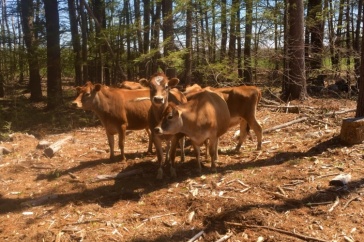 Name: Christina DiMeo '18 (University Honors Program)
Name: Christina DiMeo '18 (University Honors Program)
College: Life Sciences and Agriculture
Major: Genetics
Hometown: Absecon, New Jersey
Award: REAP (Research Experience and Apprenticeship Program)
Faculty Mentor: Professor Adrienne Kovach, Natural Resources
Topic: Approaches for Genetic Monitoring of Imperiled New England Cottontails
Christina DiMeo wanted experience conducting research, and she really likes animals, so it would seem she’s found the perfect summer job. DiMeo received a Research Experience and Apprenticeship Program award to spend 10 weeks conducting genetic research on the New England cottontail rabbit, an endangered species in New Hampshire and a candidate for federal protection under the Endangered Species Act. We caught up with DiMeo in her Rudman Hall laboratory to ask about her work.
UNH Today: Tell us about your research.
DiMeo: I’m focused on conservation genetics. I’m analyzing rabbit pellets to determine which pellets belong to which rabbits. New England cottontails are very endangered, and we’re trying to determine the size of their populations by extracting DNA from pellet samples. We get samples from Maine, New York, New Hampshire and Connecticut. With the DNA, we find out which rabbit species it is. The pellet samples that I am working on are from an area where Eastern cottontails, which are a plentiful invasive species and competitor to New England cottontails, were removed and replaced with New England cottontails. We’re trying to see how well those New England cottontails survived during the past year. We use individual genes to match the individual rabbits, so we know which bunny is alive and where it’s from. Right now I’m learning how to do all the lab techniques.
UNH Today: Why is the Eastern cottontail doing all right but the New England cottontail is not?
DiMeo: The Eastern cottontail can live in a wider variety of habitats than the New England cottontail. New England cottontails need a specific habitat of brush, which is usually near roadsides or in fields. Houses and development are interfering with that habitat. It’s sad to lose something that’s there. Everything has its place in the food chain and the environment, including bunnies. They are food for some species, and they eat certain species, too, so they help keep a balance. It’s really their role in the environment; they need to be there for other creatures.

Christina DiMeo '18 explains how she prepares rabbit pellets for DNA extraction: “In this step, I mash up the pellets in a buffer to separate the cells from the solids of the pellet. Once all the solids are removed, a reaction is induced that breaks down the cell membrane so the DNA is released into a solution. The solution is washed by a few different chemicals until I am left with DNA, which will be amplified and analyzed later.”
-
Written By:
Valerie Lester | Communications and Public Affairs | valerie.lester@unh.edu | (603) 862-2632

















































